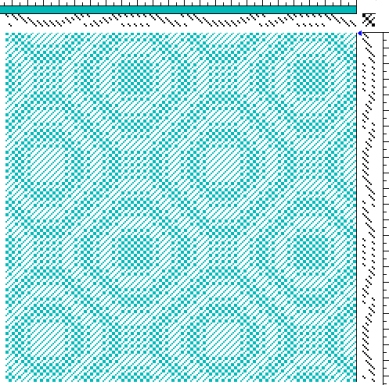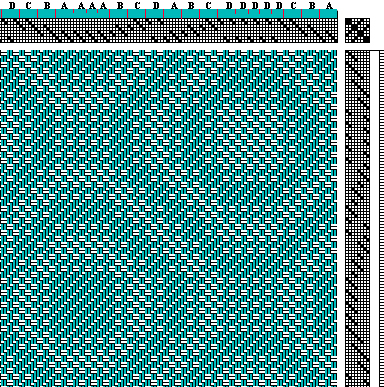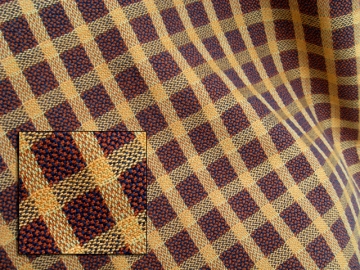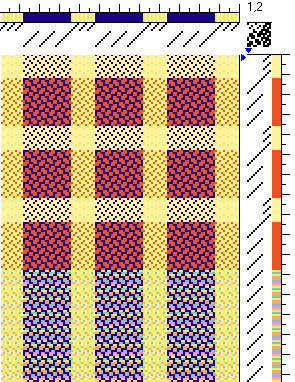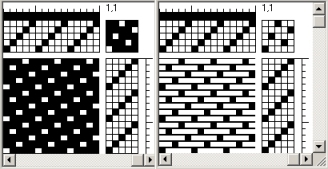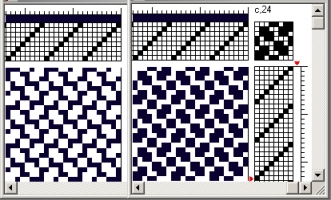I looked up damassé in Irene Emery’s book, The Primary Structures of Fabrics, and learned that it’s a French term referring to fabrics or weaves that are damask-like. The main difference between damask and damassé, as I understand it, is that the patterns in damask are produced by one weave structure which in many instances is turned satin, while in damassé the patterns are produced by two different weave structures. Alice Schlein explains how to design a combination of 8-end satin and plain weave damassé cloth in her book, Network Drafting, An Introduction, page 56. There is also a very interesting post about damassé on Alice’s website. I searched further and found Betty Lou Whaley’s “Snail Trail,” 8-shaft, 4-block, damassé draft, combining basket weave and halftone twill in the Complex Weavers Greatest Hits book, edited by Judie Eatough and Wanda J. Shelp. At this point I decided to weave samples as I was really curious about all this, and after numerous sampling finally wove some yardage. Here are a few highlights from my damassé experience:
Following Alice’s method for designing 8-end satin and plain weave damassé, I designed and wove a sample except that I combined 8-end satin and basket weave. The design part includes networking the threading pattern line using initial 8 and cutting and pasting in the liftplan. I weave on a 16-shaft treadle loom so I converted the liftplan to tie-up mode, and I saw that I didn’t have enough treadles and the treadling itself looked like I would have to play a complex piece on the piano with my feet. However, I did manage to weave Sample #1 below using 20/2 cotton, two strands together, for both the tan warp and the black weft, sett at 36 epi. I like how the satin areas are raised and stand out from the basket weave areas like in a relief.

Damassé Partial Draft #1 (8-end satin and basket weave, networked initial 8 threading, 16 shafts, interlacement view)
I used Mary Lou’s method to design and weave Sample #2, a 4-block combination of twill and basket weave on 8 shafts. One side shows 1/3 twill and the other side 3/1 twill. Mary Lou calls it halftone twill because the blocks overlap so the number of shafts needed is reduced. Block A is threaded: 1,2,3,4,1,2; Block B: 3,4,5,6,3,4; Block C: 5,6,7,8,5,6; Block D: 7,8,1,2,7,8; if the same block is repeated then only the first 4 threads are repeated so, for example, you might have: 1,2,3,4,1,2,3,4,1,2. In the sample below I used 20/2 cotton two strands together, for both the blue warp and white weft, sett at 30 epi.
So now I thought to myself why not try an initial 4 networked pattern line instead of using blocks when combining twill and basket weave. Here’s one of the drafts I designed this way:
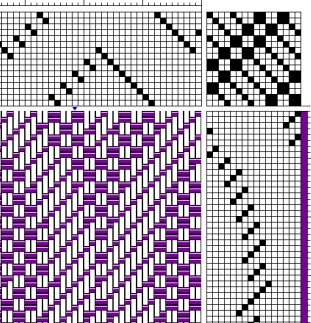
Damassé Partial Draft #3 (twill and basket weave, networked initial 4, 16 shafts, interlacement view)
I liked Draft #3, but I wanted something more interesting with even less clean-cut pattern edges and came up with a new design and wove some yardage using 10/2 Tencel and 10/2 pearl cotton, sett at 30 epi. The close-up below shows the finished woven fabric and the inset shows the computer generated drawdown. I think the finished fabric may be suitable for a nice vest or jacket.

Damassé Woven Yardage (twill and basket weave, networked initial 4, 16 shafts, Tencel warp & pearl cotton weft, 2019)
After so many years of weaving I still get a thrill from learning something new. Hope you enjoyed this post.
See you next time!



